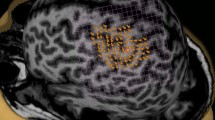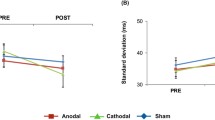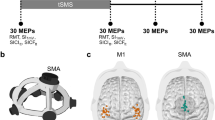Abstract
Objective: The increasing therapeutic use of transcranial magnetic stimulation (TMS) in disorders of cortical excitability raises the need for reliable stimulus variables. Stimulation of cortical motor areas influences motor programming and execution. We investigated the effects of TMS delivered over various cortical motor areas during the reaction time (RT) on the execution of sequential rapid arm movements in healthy subjects. Methods: Subjects performed a five-submovement (S1–S5) motor sequence mainly involving upper limb proximal muscles. RT and movement time (MT) were measured. We delivered late (close to movement onset) and early (close to the go signal) TMS over the primary motor area (M1-FDI hot-spot for the first dorsal interosseus, M1-D hot-spot for the deltoid muscle), the premotor (PM) area, and the supplementary motor area (SMA), using subthreshold and suprathreshold intensity, single and triple pulses. Results: The motor sequence showed a characteristic pattern of submovement duration, S2–S3–S4 being faster than S1 and S5. Late TMS prolonged RT only when high-intensity pulses were delivered over M1-FDI. Single- and triple-pulse TMS over M1-D or M1-FDI significantly prolonged MT with a dose-related effect. Suprathreshold triple-pulse TMS over the PM—but not over the SMA—also lengthened the MT but did not change RT. Early triple-pulse TMS reduced the RT independently from the stimulus intensity and scalp site. SMA and PM—but not M1-D—stimulation also reduced the MT. Single-pulse TMS over the SMA, despite being delivered through a double-cone coil, did not change RT or MT. Conclusions: TMS-induced changes in the kinematics of a sequential arm movement depend closely on the timing of TMS interference, the scalp site stimulated, and the intensity (and number) of stimuli delivered. Late TMS interference inhibits, whereas early interference facilitates, motor performance. The cortical motor region most sensitive to TMS-induced inhibition is that below the scalp site for M1-FDI. In contrast, TMS-induced facilitation has no strict topographic organization. Particularly for MT (although inhibitory and facilitatory effects both depend on stimulation at high intensities) intensity is less crucial than timing of interference and scalp site.









Similar content being viewed by others
References
Berardelli A, Inghilleri M, Polidori L, Priori A, Mercuri B, Manfredi M (1994) Effects of transcranial magnetic stimulation on single and sequential arm movements. Exp Brain Res 98:501–506
Bernstein IH, Clark MH, Edelstein BA (1969) Effects of an auditory signal on visual reaction time. J Exp Psychol 80:567–569
Boylan LS, Pullman SL, Lisamby SH, Spicknall KE, Sackeim HA (2001) Repetitive transcranial magnetic stimulation to SMA worsens complex movements in Parkinson’s disease. Clin Neurophysiol 112:259–264
Cerri G, Shimazu H, Maier MA, Lemon RN (2003) Facilitation from ventral premotor cortex of primary motor cortex outputs to macaque hand muscles. J Neurophysiol 90:832–842
Chen R, Tam A, Butefisch C, Corwell B, Ziemann U, Rothwell JC, Cohen LG (1998) Intracortical inhibition and facilitation in different representations of the human motor cortex. J Neurophysiol 80:2870–2881
Cunnington R, Iansek R, Thickbroom GW, Laing BA, Mastaglia FL, Bradshaw JL, Philips JG (1996) Effects of magnetic stimulation over supplementary motor area on movement in Parkinson’s disease. Brain 119:815–822
Currà A, Berardelli A, Agostino R, Modugno N, Puorger CC, Accornero N, Manfredi M (1997) Performance of sequential arm movements with and without advance knowledge of motor pathways in Parkinson’s disease. Mov Disord 12:646–654
Currà A, Agostino R, Galizia P, Fittipaldi F, Manfredi M, Berardelli A (2000) Submovement cueing and motor sequence execution in patients with Huntington’s disease. Clin Neurophysiol 111:1184–1190
Day BL, Rothwell JC, Thompson PD, de Noordhout AM, Nakashima K, Shannon K, Marsden CD (1989) Delay in the execution of voluntary movement by electrical or magnetic brain stimulation in intact man. Evidence for the storage of motor programs in the brain. Brain 112:649–663
Dum RP, Strick PL (1991) The origin of corticospinal projection from the premotor areas in the frontal lobe. J Neurosci 11:667–689
Gerloff C, Richard J, Hadley J, Schulman AE, Honda M, Hallett M (1997) Functional coupling and regional activation of human cortical motor area during simple, internally paced and externally paced of finger movements. Brain 121:1513–1531
Geyer S, Matelli M, Luppino G, Zilles K (2000) Functional neuroanatomy of the primate isocortical motor system. Anat Embryol (Berl) 202:443–474
Halsband U, Ito N, Tanji J, Freund HJ (1993) The role of premotor cortex and the supplementary motor area in the temporal control of movement in man. Brain 116:243–266
Martino AM, Strick PL (1987) Corticospinal projections originate from the arcuate premotor area. Brain Res 404:307–312
Mushiake H, Inase M, Tanji J (1991) Neuronal activity in the primate premotor, supplementary, and precentral motor cortex during visually guided and internally determined sequential movements. J Neurophysiol 66:705–718
Nickerson RS (1973) Intersensory facilitation of reaction time: energy summation or preparation enhancement? Psychol Rev 80:489–509
Pascual-Leone A, Brasil-Neto J, Vails-Solè J, Cohen LJ, Hallett M (1992a) Simple reaction time to focal transcranial magnetic stimulation: comparison with reaction time to acoustic, visual and somatosensory stimuli. Brain 115:109–122
Pascual-Leone A, Valls-Solè J, Wasermann EM, Brasil-Neto J, Cohen LJ, Hallett M (1992b) Effect of focal transcranial magnetic stimulation on simple reaction time to acoustic, visual and somatosensory stimuli. Brain 115:1045–1159
Pascual-Leone A, Valls-Sole J, Brasil-Neto JP, Cohen LG, Hallett M (1994a) Akinesia in Parkinson’s disease. I. Shortening of simple reaction time with focal, single-pulse transcranial magnetic stimulation. Neurology 44:884–891
Pascual-Leone A, Valls-Sole J, Brasil-Neto JP, Cammarota A, Grafman J, Hallett M (1994b) Akinesia in Parkinson’s disease. II. Effects of subthreshold repetitive transcranial motor cortex stimulation. Neurology 44:892–898
Sadato N, Campbell G, Ibanez V, Deiber M, Hallett M (1996) Complexity affects regional cerebral blood flow change during sequential finger movements. J Neurosci 16(8):2691–2700
Schluter ND, Rushworth MFS, Passingham RE, Mills KR (1998) Temporary interference in human lateral premotor cortex suggests dominance for the selection of movements: a study using transcranial magnetic stimulation. Brain 121:785–799
Terao Y, Ugawa Y, Sakai MSK, Gemba-Shimizu RHK, Kanazawa I (1997) Shortening of simple reaction time by peripheral electrical and submotor-threshold magnetic cortical stimulation. Exp Brain Res 115:541–545
Ziemann U, Tergau F, Netz J, Homberg V (1997) Delay in simple reaction time after focal transcranial stimulation of the human brain occurs at the final motor output stage. Brain Res 744:32–40
Author information
Authors and Affiliations
Corresponding author
Rights and permissions
About this article
Cite this article
Gregori, B., Currà, A., Dinapoli, L. et al. The timing and intensity of transcranial magnetic stimulation, and the scalp site stimulated, as variables influencing motor sequence performance in healthy subjects. Exp Brain Res 166, 43–55 (2005). https://doi.org/10.1007/s00221-005-2337-3
Received:
Accepted:
Published:
Issue Date:
DOI: https://doi.org/10.1007/s00221-005-2337-3




